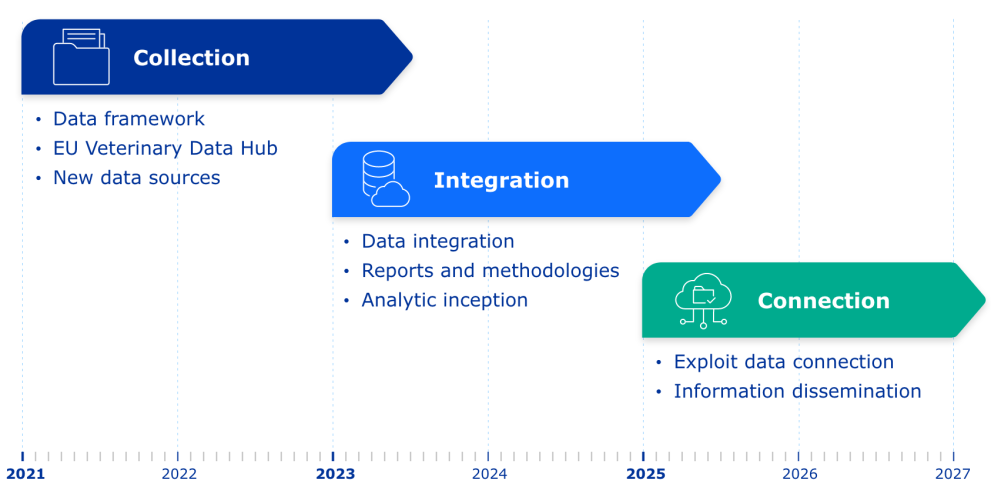EMA, national competent authorities and pharmaceutical companies use digital systems in the regulation of veterinary medicines in the EU, which gather and process crucial data for the regulation of veterinary medicines. Some of these serve to implement the Veterinary Medicinal Products Regulation in force since January 2022, including the Union Product Database.
Meanwhile, animal health professionals and users of veterinary medicines increasingly use digital technologies in farm management and animal healthcare practices, which also generate large amounts of data. This reflects a general societal trend, whereby massive amounts of data are generated on a daily basis that could potentially be harnessed to support medicines regulation.
More information:
Veterinary big data strategy and workplan
The joint EMA/HMA veterinary big data strategy sets out how the European medicines regulatory network intends to make use of new digital technologies and preparing for future changes in the realm of big data.
The strategy involves:
- Increasing system interoperability and re-usability of data in different regulatory areas and product lifecycle stages;
- Reducing administrative burden for medicine developers and marketing authorisation holders;
- Ensuring data quality, consistency and connectedness across the European medicines regulatory network.
It covers the following regulatory topics:
- Union Product Database
- Pharmacovigilance (veterinary medicines)
- European Surveillance of Veterinary Antimicrobial Consumption (ESVAC)
- Environmental risk assessment of veterinary medicines
- Regulatory submission and evaluation
- Manufacturing / inspections coordination
- Innovative use of digital technologies
EU veterinary big data workplan sets out the key milestones and timelines for the veterinary big data initiative from 2023 to 2025.
EMA and the Heads of Medicines (HMA) endorsed the workplan in May 2023.
Implementation phases
The European medicines regulatory network plans to implement the veterinary big data strategy in three main phases between 2021 and 2027:

Data collection
The short-term data collection phase involves the following activities:
- Gathering complete medicinal product data in the Union Product Database (UPD) established under the Veterinary Medicinal Products Regulation.
- Enabling system integration, whereby UPD data feed into other systems used by EMA and veterinary medicine regulators, such as EudraVigilance Veterinary.
- Mapping and identifying other sources of data and real-world evidence that may support the regulation of veterinary medicines in the EU.
- Establishing a network of experts, known as the EU Veterinary Data Hub, to provide expertise in data management and analysis in the veterinary medicines field.
This phase began in 2021 and is expected to run until 2023 or beyond.
Data integration
The medium-term data integration phase involves integrating data into key regulatory areas and procedures, such as:
- medicine information management (e.g. on supply shortages);
- pharmacovigilance;
- antimicrobials.
It also involves preparing tools and methods for data analysis.
This phase is expected to run from 2023 to 2025 or beyond.
Data connection
The long-term data connection phase involves developing and enhancing analytical tools and exploiting data-connectedness in key regulatory areas. It is set to involve the use of new technical solutions, data sources and real-world evidence.
The main ambition of this phase is to help establish data-driven practices in the regulatory field based on real-world evidence.
It is expected to run from 2025 to 2027.
Data literacy programme and EU Veterinary Data Hub
Promoting a data culture within the European medicines regulatory network prepares it to respond to an increasingly complex digital environment.
EMA is responsible for two related initiatives:
- Data literacy programme - an initiative aimed at developing the expertise necessary to address data-related requests in an effective manner.
- EU Veterinary Data Hub - a network of multidisciplinary experts building the methods to respond to data analysis requests.
The Veterinary Data Hub includes experts from Belgium, France, Germany, Portugal, Spain and Sweden. It was established in June 2023.
Stakeholder engagement
Thestakeholders standing to benefit from the strategy include:
- veterinary pharmaceutical industry;
- animal health professionals;
- farm and companion animal health-system providers;
- academics;
- EU agencies and institutions;
- regulators worldwide.
EMA and HMA organise veterinary big data stakeholder forums each year for all interested parties. These aim to build awareness of the use of innovative digital technologiesin the regulation of veterinary medicines, and to discuss progress in implementing the veterinary big data strategy.
More information:
- Third Veterinary Big Data stakeholder forum (23/11/2023)
- Second Veterinary Big Data stakeholder forum (23/11/2022)
- First Veterinary Big Data stakeholder forum (01-02/06/2021)
EMA's quarterly Veterinary Medicinal Products Regulation newsletter contains a round-up of latest developments in the field of veterinary big data:
To receive the newsletter by email, please send an email to vet-bigdata@ema.europa.eu.